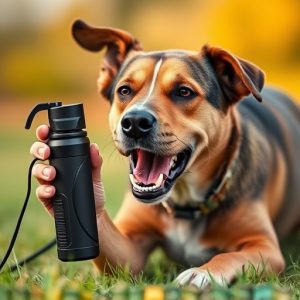Pepper Spray for Dogs: Effective Science-Backed Prevention
Aggressive dog behavior stems from fear, territoriality, pain, illness, or past trauma, which can be…….
Aggressive dog behavior stems from fear, territoriality, pain, illness, or past trauma, which can be mitigated through creating safe environments, training, exercise, and proper nutrition. Pepper spray formulations for aggressive dogs disrupt their sensory system by targeting eyes and nostrils with capsaicin, causing temporary blindness and breathing difficulty. When using pepper spray as a deterrent, focus on products designed specifically for canine aggression management, with balanced capsaicin concentrations and reliable delivery systems. Apply the spray precisely and controlled, as a last resort after other calming methods, ensuring good ventilation and monitoring post-treatment behavior.
“Unleashing safety measures against aggressive dog behavior, this article delves into an unconventional yet potent tool: pepper spray. Understanding the science behind its formulation and effectiveness is crucial in addressing potential hazards. We explore key triggers of aggression and preventive strategies, focusing on the role of pepper spray as a last resort. This guide covers everything from product selection to application techniques, ensuring both safety and success when dealing with challenging canine behavior.”
- Understanding Aggressive Dog Behavior: Key Triggers and Prevention Strategies
- The Science Behind Pepper Spray Formulations for Dogs
- Efficacy and Safety Considerations: What to Look for in a Product
- Application Techniques and Post-Treatment Care for Maximum Effectiveness
Understanding Aggressive Dog Behavior: Key Triggers and Prevention Strategies
Aggressive dog behavior can stem from a variety of factors, and understanding these triggers is crucial for prevention and effective management. Key triggers include fear, territoriality, pain or illness, and past traumatic experiences. Dogs may display aggression when they feel their safety or resources are threatened, or as a way to protect their young.
Prevention strategies focus on creating a safe environment, positive reinforcement training, and early intervention. Regular exercise, proper nutrition, and socialization can reduce fear-based aggression. Training should emphasize calmness and patience, using rewards rather than punishment. For owners dealing with pepper spray formulation against aggressive dogs, understanding these behaviors is essential for choosing the right de-escalation tool.
The Science Behind Pepper Spray Formulations for Dogs
The effectiveness of pepper spray formulations for dogs relies on their ability to disrupt the dog’s sensory system, specifically the eyes and nostrils. These sprays contain capsaicin, the active ingredient found in chili peppers, which triggers a chain reaction when it comes into contact with a dog’s mucous membranes. This leads to temporary blindness, irritation, and difficulty breathing, causing the dog to retreat and de-escalate.
Modern pepper spray formulations for aggressive dogs are designed with a careful balance of capsaicin concentration and carriers. The former ensures a strong enough reaction without causing prolonged harm or distress, while the latter helps to distribute the spray evenly and quickly. This science-backed approach aims to provide a safe and efficient tool for dog handlers and owners, offering a non-lethal means to control aggressive behavior and ensure both human and animal safety.
Efficacy and Safety Considerations: What to Look for in a Product
When considering pepper spray as a deterrent for aggressive dogs, understanding its efficacy and safety is paramount. Look for products designed specifically to address canine aggression, focusing on formulations tailored for maximum impact while minimizing risk to both humans and animals.
Effective pepper spray for aggressive dogs should contain potent yet safe capsaicin, the compound responsible for the burning sensation. The formulation should be carefully balanced to ensure it disrupts the dog’s behavior without causing severe or lasting harm. Additionally, consider products with a reliable delivery system that ensures consistent application, ensuring the spray reaches the target area effectively. Always opt for brands that prioritize animal welfare and adhere to safety standards in their manufacturing processes.
Application Techniques and Post-Treatment Care for Maximum Effectiveness
When applying pepper spray against aggressive dogs, understanding proper technique is crucial for maximum effectiveness. The key lies in delivering a precise and controlled burst directly into the dog’s face and eyes. Aiming for the nose and mouth area ensures irritation of sensitive mucous membranes, temporarily disorienting and distracting the animal. It’s important to note that pepper spray should be used as a last resort when all other calming methods have failed, and it must be applied responsibly to avoid harming either the dog or the user.
Post-treatment care is equally vital. After spraying, ensure the area is well-ventilated to minimize residual effects. Keep the treated dog in a safe, enclosed space to prevent them from causing harm to themselves or others while the spray wears off. Monitoring their behavior and providing comfort can help ease the dog’s distress. In terms of pepper spray formulation against aggressive dogs, products designed specifically for this purpose often contain higher concentrations of capsaicin, the active ingredient responsible for the burning sensation. These formulations are carefully balanced to be safe for both humans and animals when used appropriately.
When faced with aggressive dog behavior, understanding the science behind effective deterrents like pepper spray formulations is crucial. By identifying triggers and implementing prevention strategies alongside the right product choices and application techniques, owners can ensure their safety and that of others while mitigating the dog’s aggression. Remember, responsible use of pepper spray for aggressive dogs involves careful consideration of efficacy, safety, and post-treatment care, making it a valuable tool in navigating challenging canine behaviors.


